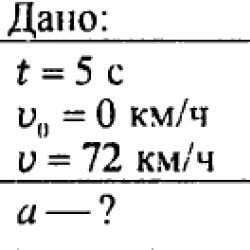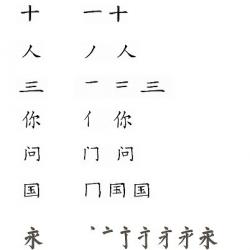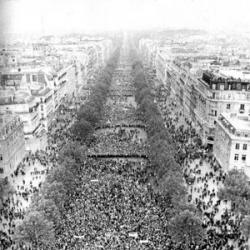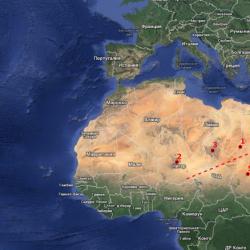Coordinate equation for uniform and uniformly accelerated motion. Uniform, uniformly accelerated linear motion. Free fall velocity determination problem
1439. A motorcycle can increase its speed from 0 to 72 km/h within 5 s. Determine the acceleration of the motorcycle.

1440. Determine the acceleration of the elevator in a high-rise building if it increases its speed by 3.2 m/s within 2 s.

1441. A car moving at a speed of 72 km/h brakes uniformly and stops after 10 s. What is the acceleration of the car?

1442. What do you call movements in which the acceleration is constant? equal to zero?
Uniformly accelerated, uniform.
1443. A sled, rolling down a mountain, moves uniformly accelerated and at the end of the third second from the start of movement it has a speed of 10.8 km/h. Determine the acceleration with which the sled is moving.

1444. The speed of a car increased from 0 to 60 km/h in 1.5 minutes of movement. Find the acceleration of the car in m/s2, in cm/s2.

1445. A Honda motorcycle, moving at a speed of 90 km/h, began to brake evenly and after 5 s dropped the speed to 18 km/h. What is the acceleration of the motorcycle?

1446. An object from a state of rest begins to move with a constant acceleration equal to 6 10-3 m/s2. Determine the speed 5 minutes after the start of movement. How far did the object travel during this time?

1447. The yacht is launched onto inclined slipways. She covered the first 80 cm in 10 seconds. How long did it take the yacht to cover the remaining 30 m if its motion remained uniformly accelerated?

1448. A truck starts from rest with an acceleration of 0.6 m/s2. How long will it take him to cover a distance of 30 m?

1449. An electric train leaves the station, moving uniformly accelerated for 1 min 20 s. What is the acceleration of the train if during this time its speed became 57.6 km/h? How far did she travel in the specified time?

1450. For takeoff, the plane accelerates uniformly within 6 s to a speed of 172.8 km/h. Find the acceleration of the plane. How far did the plane travel during acceleration?

1451. A freight train, starting off, moved with an acceleration of 0.5 m/s2 and accelerated to a speed of 36 km/h. What path did he take?

1452. The fast train set off from the station with uniform acceleration and, having traveled 500 m, reached a speed of 72 km/h. What is the acceleration of the train? Determine its acceleration time.

1453. When leaving the cannon barrel, the projectile has a speed of 1100 m/s. The length of the cannon barrel is 2.5 m. Inside the barrel, the projectile moved uniformly accelerated. What is its acceleration? How long did it take for the projectile to travel the entire length of the barrel?

1454. An electric train traveling at a speed of 72 km/h began to slow down with a constant acceleration equal to 2 m/s2. How long will it take for it to stop? How far will it travel before it comes to a complete stop?

1455. A city bus moved uniformly at a speed of 6 m/s, and then began to slow down with an acceleration modulus equal to 0.6 m/s2. How long before stopping and at what distance from it should you start braking?

1456. A sled slides along an ice path with an initial speed of 8 m/s, and for every second its speed decreases by 0.25 m/s. How long will it take for the sled to stop?

1457. A scooter moving at a speed of 46.8 km/h stops with uniform braking for 2 s. What is the acceleration of the scooter? What is its braking distance?

1458. The motor ship, sailing at a speed of 32.4 km/h, began to slow down evenly and, approaching the pier after 36 seconds, came to a complete stop. What is the acceleration of the ship? How far did he travel during braking?

1459. The freight train, passing the barrier, began to slow down. After 3 minutes he stopped at a junction. What is the initial speed of the freight train and its acceleration modulus if the barrier is located 1.8 km from the crossing?

1460. The braking distance of the train is 150 m, braking time is 30 s. Find the initial speed of the train and its acceleration.

1461. An electric train moving at a speed of 64.8 km/h, after starting to brake, traveled 180 m to a complete stop. Determine its acceleration and braking time.

1462. The airplane flew uniformly at a speed of 360 km/h, then for 10 s it moved uniformly accelerated: its speed increased by 9 m/s per second. Determine what speed the airplane acquired. How far did he travel with uniform acceleration?

1463. A motorcycle moving at a speed of 27 km/h began to accelerate uniformly and after 10 s reached a speed of 63 km/h. Determine the average speed of the motorcycle during uniformly accelerated motion. How far did he travel during uniformly accelerated motion?

1464. The device counts time intervals equal to 0.75 s. The ball rolls down the inclined chute during three such periods of time. Having rolled down the inclined chute, it continues to move along the horizontal chute and passes 45 cm during the first period of time. Determine the instantaneous speed of the ball at the end of the inclined chute and the acceleration of the ball while moving along this chute.

1465. Leaving the station, the train moves uniformly with an acceleration of 5 cm/s2. After what time does the train reach a speed of 36 km/h?

1466. When a train departs from the station, its speed increases to 0.2 m/s during the first 4 s, by another 30 cm/s over the next 6 s, and by 1.8 km/h over the next 10 s. How did the train move during these 20 s?

1467. A sled, rolling down a mountain, moves with uniform acceleration. On a certain section of the path, the speed of the sled increased from 0.8 m/s to 14.4 km/h within 4 s. Determine the acceleration of the sled.

1468. A cyclist begins to move with an acceleration of 20 cm/s2. After what time will the cyclist's speed be 7.2 km/h?

1469. Figure 184 shows a graph of the speed of some uniformly accelerated motion. Using the scale given in the figure, determine the path covered in this movement within 3.5 s.

1470. Figure 185 shows a graph of the speed of some variable motion. Draw the drawing in your notebook and mark with shading an area numerically equal to the path traveled within 3 s. What is this path approximately?

1471. During the first period of time from the beginning of uniformly accelerated motion, the ball passes along a groove of 8 cm. What distance will the ball travel during three such intervals from the beginning of the motion?

1472. During 10 equal periods of time from the beginning of the movement, the body, moving uniformly accelerated, traveled 75 cm. How many centimeters did this body travel during the first two equal periods of time?

1473. A train, leaving the station, moves uniformly accelerated and travels 12 cm during the first two seconds. What distance will the train travel within 1 minute, counting from the start of movement?

1474. A train, leaving the station, moves uniformly with an acceleration of 5 cm/s2. How long will it take to reach a speed of 28.8 km/h and how far will the train travel during this time?

1475. A steam locomotive along a horizontal track approaches a slope at a speed of 8 m/s, then moves down the slope with an acceleration of 0.2 m/s. Determine the length of the slope if the locomotive passes it in 30 s.

1476. The initial speed of a cart moving down an inclined board is 10 cm/s. The cart traveled the entire length of the board, equal to 2 m, within 5 seconds. Determine the acceleration of the cart.

1477. A bullet flies out of a gun barrel at a speed of 800 m/s. The length of the barrel is 64 cm. Assuming the motion of the bullet inside the barrel is uniformly accelerated, determine the acceleration and time of motion.

1478. A bus, moving at a speed of 4 m/s, begins to accelerate uniformly by 1 m/s per second. How far will the bus travel in six seconds?

1479. The truck, having a certain initial speed, began to move uniformly accelerated: in the first 5 s it traveled 40 m, and in the first 10 s - 130 m. Find the initial speed of the truck and its acceleration.

1480. The boat, leaving the pier, began uniformly accelerated movement. After traveling some distance, he reached a speed of 20 m/s. What was the speed of the boat at the moment when it sailed half this distance?

1481. A skier slides down a mountain with zero initial speed. In the middle of the mountain his speed was 5 m/s, after 2 s the speed became 6 m/s. Assuming that it increases uniformly, determine the speed of the skier 8 s after the start of movement.

1482. The car has started and is moving at uniform acceleration. During what second from the start of movement, the distance traveled by the car is twice the distance traveled by it in the previous second?

1483. Find the distance covered by the body in the eighth second of motion if it begins to move uniformly accelerated without an initial speed and covers a distance of 27 m in the fifth second.

1484. The mourners stand at the beginning of the head car of the train. The train starts and moves with uniform acceleration. In 3 seconds, the entire lead car passes by the mourners. How long will it take for the entire train, consisting of 9 cars, to pass by the mourners?

1485. A material point moves according to the law x = 0.5t². What kind of movement is this? What is the acceleration of the point? Plot a graph versus time:
a) coordinates of the point;
b) point speed;
c) acceleration.

1486. The train stopped 20 s after the start of braking, having covered 120 m during this time. Determine the initial speed of the train and the acceleration of the train.
1488. Construct graphs of the speed of uniformly slow motion for the cases:
1) V0 = 10 m/s, a = - 1.5 m/s2;
2) V0 = 10 m/s; a = - 2 m/s2.
The scale in both cases is the same: 0.5 cm – 1 m/s; o.5 cm – 1 sec.

1489. Draw the distance traveled during time t on the speed graph of uniformly slow motion. Take V0 = 10 m/s, a = 2 m/s2.

1490. Describe the movements, the speed graphs of which are given in Figure 186, a and b.
a) the movement will be uniformly slow;
b) first the body will move uniformly accelerated, then uniformly. On the 3rd section the movement will be uniformly slow.

This is a movement in which the speed of a body changes equally over any equal periods of time, i.e. acceleration is constant.
Examples of such motion are the free fall of bodies near the surface of the Earth and motion under the influence of a constant force.
With uniformly accelerated linear motion, the coordinate of the body changes over time in accordance with the law of motion:
![]()
Where x 0 – initial coordinate of the material point, 0 x– projection of initial speed and a x– projection of point acceleration onto axis 0 X.
Projection of the velocity of a material point onto axis 0 X in this case it changes according to the following law:
![]()
In this case, the projections of velocity and acceleration can take on different values, including negative ones.
Dependency graphs x (t) And x(t) represent a straight line and a parabola, respectively, and, as in algebra, the coefficients in the equations of a straight line and a parabola can be used to judge the location of the graph of a function relative to the coordinate axes.
|
|
Figure 6 shows graphs for x(t),x (t),s(t) when x 0 > 0, 0 x > 0,a x < 0. Соответственно прямая(t) has a negative slope (tg =a x < 0).
3. Rotational motion and its kinematic parameters. Relationship between angular and linear speeds.
Uniform movement around a circle occurs at a constant absolute speed, i.e. = const (Fig. 7). However, the direction of velocity during such motion continuously changes, therefore the uniform motion of a body in a circle is motion with acceleration.

To describe the uniform motion of a body in a circle, the following physical quantities are introduced: period,circulation frequency,linear speed,angular velocity And centripetal acceleration.
Circulation periodT– the time it takes to complete one full revolution.
Frequency is the number of revolutions made by the body in 1 s. The SI unit of frequency of circulation is c –1.
Frequency and period of revolution are related by the relation.
When a point moves around a circle, the velocity vector constantly changes its direction (Fig. 8).
With uniform motion of a body in a circle, the path segment s, traveled during a period of time t, is the length of the arc of a circle. The relationship is constant over time and is called linear speed module. For a time equal to the circulation period T, the point travels a distance equal to the circumference of the circle 2 R, That's why
![]()

The speed of rotation of solid bodies is usually characterized by a physical quantity called angular velocity , the module of which is equal to the ratio of the angle of rotation of the body to the period of time during which this rotation is completed (Fig. 8):
The SI unit of angular velocity is c –1.
Since the orientation of a rigid body is the same in all reference systems moving translationally relative to each other, the angular velocity of rotation of the rigid body will be the same in all reference systems moving translationally relative to each other.
With uniform rotation of a rigid body about a certain axis, any point of this body moves around the same axis in a circle of radius R with linear speed, which is equal to
If the initial coordinates of the point are equal ( R; 0), then its coordinates change according to the law x(t) =R cos t And y(t) =R sin t.
What is uniformly accelerated motion?
In physics, uniformly accelerated motion is considered to be a motion whose acceleration vector does not change in magnitude and direction. In simple terms, uniformly accelerated motion is uneven motion (that is, moving at different speeds), the acceleration of which is constant over a certain period of time. Let's imagine that it starts moving, for the first 2 seconds its speed is 10 m/s, for the next 2 seconds it is already moving at a speed of 20 m/s, and after another 2 seconds it is already moving at a speed of 30 m/s. That is, every 2 seconds it accelerates by 10 m/s, such movement is uniformly accelerated.
From here we can derive an extremely simple definition of uniformly accelerated motion: this is the movement of any physical body in which its speed changes equally over equal periods of time.
Examples of uniformly accelerated motion
A clear example of uniformly accelerated motion in everyday life would be a bicycle going down a hill (but not a bicycle driven by a cyclist), or a stone being thrown at a certain angle to the horizon.
By the way, the example with the stone can be considered in more detail. At any point in the flight path, the stone is affected by the acceleration of gravity g. The acceleration g does not change, that is, it remains constant and is always directed in one direction (in fact, this is the main condition for uniformly accelerated motion).
It is convenient to imagine the flight of a thrown stone as a sum of movements relative to the vertical and horizontal axis of the coordinate system.

If along the X axis the movement of the stone is uniform and rectilinear, then along the Y axis it will be uniformly accelerated and rectilinear.
Formula for uniformly accelerated motion
The speed formula for uniformly accelerated motion will look like this:
Where V 0 is the initial velocity of the body, and is the acceleration (as we remember, this value is a constant), t is the total flight time of the stone.
With uniformly accelerated motion, the dependence V(t) will look like a straight line.

Acceleration can be determined from the slope of the velocity graph. In this figure, it is equal to the ratio of the sides of triangle ABC.

The larger the angle β, the greater the slope and, as a consequence, the steepness of the graph relative to the time axis, and the greater the acceleration of the body.
- Sivukhin D.V. General course in physics. - M.: Fizmatlit, 2005. - T. I. Mechanics. - P. 37. - 560 p. - ISBN 5-9221-0225-7.
- Targ S. M. Short course in theoretical mechanics. - 11th ed. - M.: “Higher School”, 1995. - P. 214. - 416 p. - ISBN 5-06-003117-9.
Uniformly accelerated motion, video
Graphical representation of uniform linear motion
Mechanical movement is represented graphically. The dependence of physical quantities is expressed using functions. Designate:
V (t) - change in speed over time
a(t) - change in acceleration over time
Behind acceleration versus time. Since during uniform motion the acceleration is zero, the dependence a(t) is a straight line that lies on the time axis.

Dependence of speed on time. Since the body moves rectilinearly and uniformly (v = const), i.e. the speed does not change with time, then the graph with the dependence of speed on time v(t) is a straight line parallel to the time axis.

The projection of the body's movement is numerically equal to the area of the rectangle AOBC under the graph, since the magnitude of the movement vector is equal to the product of the velocity vector and the time during which the movement was made.

The rule for determining the path using the graph v(t): in case of rectilinear uniform motion, the magnitude of the displacement vector is equal to the area of the rectangle under the velocity graph.

Dependence of displacement on time. Graph s(t) - sloping line :
The graph shows that the projection of the velocity is equal to:
![]()
Having considered this formula, we can say that the larger the angle, the faster the body moves and it covers a greater distance in less time.
The rule for determining speed from the graph s(t): The tangent of the angle of inclination of the graph to the time axis is equal to the speed of movement.
Uneven straight motion.
Uniform motion is motion at a constant speed. If the speed of a body changes, it is said to be moving unevenly.
A movement in which a body makes unequal movements at equal intervals of time is called uneven or variable movement.
To characterize uneven motion, the concept of average speed is introduced.

Average driving speed equal to the ratio of the entire path traveled by a material point to the period of time during which this path was traveled.
In physics, the greatest interest is not the average, but instantaneous speed , which is defined as the limit to which the average speed tends over an infinitesimal period of time Δ t:

Instant speedvariable motion is the speed of a body at a given point in time or at a given point on the trajectory.
The instantaneous velocity of a body at any point on a curvilinear trajectory is directed tangentially to the trajectory at that point.
The difference between average and instantaneous speeds is shown in the figure.

The movement of a body in which its speed changes equally over any equal periods of time is called uniformly accelerated or uniformly alternating motion.
Acceleration -this is a vector physical quantity that characterizes the rate of change in speed, numerically equal to the ratio of the change in speed to the period of time during which this change occurred.
If the speed changes equally throughout the entire movement, then the acceleration can be calculated using the formula:

Designations:
V x - Velocity of a body during uniformly accelerated motion in a straight line
V x o - Initial velocity of the body
a x - Body acceleration
t - Time of body movement
Acceleration shows how quickly the speed of a body changes. If the acceleration is positive, then the speed of the body increases, the movement is accelerated. If the acceleration is negative, it means the speed is decreasing and the movement is slow.
The SI unit of acceleration is [m/s2].
Acceleration is measured accelerometer
Speed equation for uniformly accelerated motion:v x = v xo + a x t
Equation of uniformly accelerated rectilinear motion(movement during uniformly accelerated motion):
![]()
Designations:
S x - Displacement of a body during uniformly accelerated motion in a straight line
V x o - Initial velocity of the body
V x - Velocity of a body during uniformly accelerated motion in a straight line
a x - Body acceleration
t - Time of body movement
More formulas for finding displacement during uniformly accelerated linear motion, which can be used when solving problems:

If the initial and final speeds and acceleration are known.

If the initial and final speeds of movement and the time of the entire movement are known
Graphical representation of uneven linear motion
Mechanical movement is represented graphically. The dependence of physical quantities is expressed using functions. Designate:
V(t) - change in speed over time
S(t) - change in displacement (path) over time
Mechanics
Kinematics formulas:
Kinematics
Mechanical movement
Mechanical movement is called a change in the position of a body (in space) relative to other bodies (over time).
Relativity of motion. Reference system
To describe the mechanical movement of a body (point), you need to know its coordinates at any moment in time. To determine coordinates, select reference body and connect with him coordinate system. Often the reference body is the Earth, which is associated with a rectangular Cartesian coordinate system. To determine the position of a point at any time, you must also set the beginning of the time count.
The coordinate system, the reference body with which it is associated, and the device for measuring time form reference system, relative to which the movement of the body is considered.
Material point
A body whose dimensions can be neglected under given motion conditions is called material point.
A body can be considered a material point if its dimensions are small compared to the distance it travels, or compared to the distances from it to other bodies.
Trajectory, path, movement
Trajectory of movement called the line along which the body moves. The path length is called the path traveled. Path– scalar physical quantity, can only be positive.
By moving is the vector connecting the starting and ending points of the trajectory.
The movement of a body in which all its points at a given moment in time move equally is called forward movement. To describe the translational motion of a body, it is enough to select one point and describe its movement.
A movement in which the trajectories of all points of the body are circles with centers on the same line and all planes of the circles are perpendicular to this line is called rotational movement.
Meter and second
To determine the coordinates of a body, you must be able to measure the distance on a straight line between two points. Any process of measuring a physical quantity consists of comparing the measured quantity with the unit of measurement of this quantity.
The unit of length in the International System of Units (SI) is meter. A meter is equal to approximately 1/40,000,000 of the earth's meridian. According to modern understanding, a meter is the distance that light travels in emptiness in 1/299,792,458 of a second.
To measure time, some periodically repeating process is selected. The SI unit of measurement of time is second. A second is equal to 9,192,631,770 periods of radiation from a cesium atom during the transition between two levels of the hyperfine structure of the ground state.
In SI, length and time are taken to be independent of other quantities. Such quantities are called main.
Instantaneous speed
To quantitatively characterize the process of body movement, the concept of movement speed is introduced.
Instant speed translational motion of a body at time t is the ratio of a very small displacement Ds to a small period of time Dt during which this displacement occurred:
Instantaneous speed is a vector quantity. The instantaneous speed of movement is always directed tangentially to the trajectory in the direction of body movement.
The unit of speed is 1 m/s. A meter per second is equal to the speed of a rectilinearly and uniformly moving point, at which the point moves a distance of 1 m in 1 s.
Acceleration
Acceleration is called a vector physical quantity equal to the ratio of a very small change in the velocity vector to the short period of time during which this change occurred, i.e. This is a measure of the rate of change of speed:
A meter per second per second is an acceleration at which the speed of a body moving rectilinearly and uniformly accelerates changes by 1 m/s in a time of 1 s.
The direction of the acceleration vector coincides with the direction of the speed change vector () for very small values of the time interval during which the speed change occurs.
If a body moves in a straight line and its speed increases, then the direction of the acceleration vector coincides with the direction of the velocity vector; when the speed decreases, it is opposite to the direction of the speed vector.
When moving along a curved path, the direction of the velocity vector changes during the movement, and the acceleration vector can be directed at any angle to the velocity vector.
Uniform, uniformly accelerated linear motion
Motion at constant speed is called uniform rectilinear movement. With uniform rectilinear motion, a body moves in a straight line and travels the same distances in any equal intervals of time.
A movement in which a body makes unequal movements at equal intervals of time is called uneven movement. With such movement, the speed of the body changes over time.
Equally variable is a movement in which the speed of a body changes by the same amount over any equal periods of time, i.e. movement with constant acceleration.
Uniformly accelerated is called uniformly alternating motion in which the magnitude of the speed increases. Equally slow– uniformly alternating motion, in which the speed decreases.







